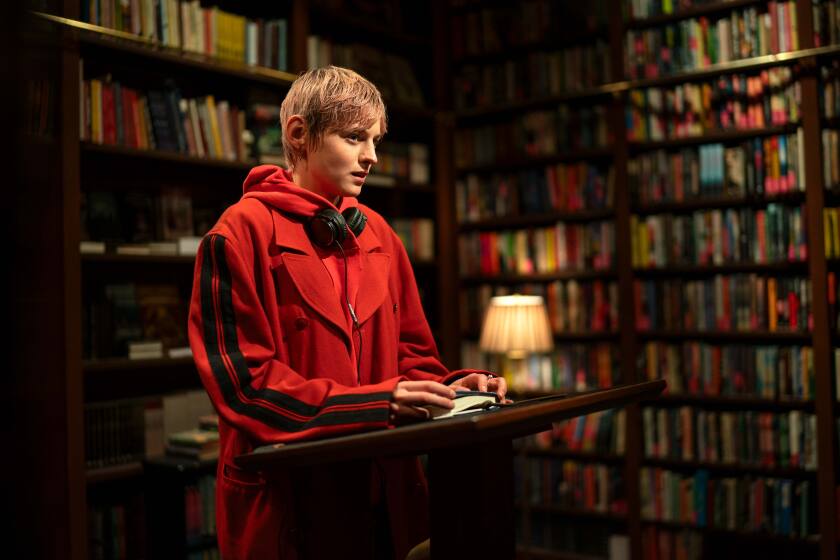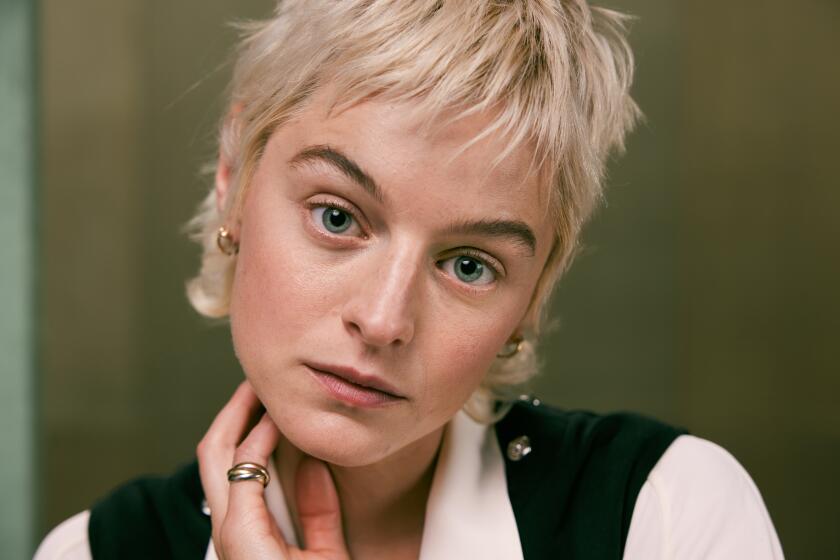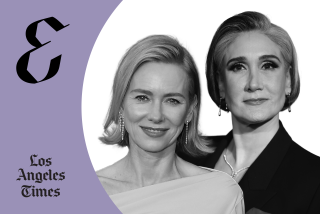
- Share via
After Brit Marling and Zal Batmanglij finished writing “A Murder at the End of the World,” Marling remembers thinking how difficult it was going to be to cast the lead, an amateur detective named Darby Hart.
“How do we find somebody who can be in literally every scene and who’s young and can be believably Gen Z and an amateur sleuth, but has a preternatural intelligence and gravitas and grace?” Marling says, speaking over Zoom alongside her eventual star, Emma Corrin. “And then I remember getting on Zoom with Emma, and within five minutes of talking, my whole body relaxed. It felt like Emma was somebody who could get at the deep core of why and how somebody operates.”

Corrin, who uses they/them pronouns, felt an instant connection to the character, a complicated, withholding tech genius with a predilection for solving murders. Corrin grew up writing their own stories as a way to process things, which felt akin to Darby, who is forced to find the killer of her ex-boyfriend, Bill (Harris Dickinson), while on a retreat in Iceland.
FX’s miniseries “A Murder at the End of the World” is an excellent, contemporary twist on an Agatha Christie-style mystery set in a snowbound Iceland hotel.
“You get glimpses in the story about how strange and bizarre her childhood was, and all that is catching up to her in real time as she’s on the retreat,” Corrin explains. “She’s having to unpack and access a lot of those parts of herself that she hasn’t let herself feel in order to solve the crime, which was such an original way of setting up the journey of a detective. It’s so seldom that [a detective] has to access vulnerability in order to do that.”

Darby was the first role Corrin took on without a point of reference, either in real life or in literature, and they found a real joy in that freedom. To create Darby’s Iowa accent, Corrin studied videos of basketball player Caitlin Clark, but otherwise looked internally to build the character. Marling and Batmanglij suggested Patricia Highsmith as a general inspiration, but there were far more examples of stoic masculine detectives than there were characters like Darby.
“Normally there are male detectives who are hard as nails and surly, and victims who are young women, and ours flipped that on its head,” Corrin says. “I went back and watched some shows that were like that to know what we were avoiding.”
“One of the neat hat tricks of ‘A Murder at the End of the World’ is that if we pull it off, the audience doesn’t realize how subversive what they’re watching is,” Marling adds. “It’s subversive to take the person who’s normally the age and gender of the victim who dies 10 minutes in and to stand that person up and clean the blood off their face and authorize them to solve the mystery. And not with a badge or a gun but just with the strength of their character and sharpness of their mind. We wanted to try to make a story where the young woman was credible going toe-to-toe with a tech billionaire. To pull that off and not have that feel like a farce was really challenging and didn’t have that much narrative precedent.”

The series shifts between two timelines, centering on the isolated retreat in the present and Darby and Bill’s relationship in the past. The production was intense, with the initial scenes shot on location in Iceland in such remote areas that Marling got hypothermia. Interiors were built on stages in New Jersey, and it was only toward the very end of shooting that a smaller crew decamped to Utah for the flashback sequences. The backward nature of the scheduling lent itself to the emotional quality on set.
“In young love or first love, the end is always contained in the beginning of falling in love with someone,” Corrin says. “And throughout being in love with someone because [the] beautiful thing about it is it’s so fragile. Knowing where Darby and Bill would end up meant that we could relax into the scenes in Utah and treat them with a real treasured-ness that I don’t know we would have done if we had done them at the start.”
“No two people are the same, even though some elements of what they’re going through might be,” Emma Corrin notes of characters in “My Policeman” and “Lady Chatterley’s Lover,” two films in which the actor has recently starred.
Because Marling directed three of the seven episodes, she wrote herself a smaller role, Lee Andersen, a brilliant hacker married to billionaire Andy Ronson (Clive Owen) who is trapped by her circumstances. Although they’re suspicious of each other in the beginning, Darby and Lee become unlikely allies and ultimately team up to take down Andy and his rogue AI. Marling says the actors never spoke too much about their relationship and that “bond was always there on set.”
That relationship too felt subversive, particularly because you rarely see stories about female mentorship onscreen. “Women are always being pitted against each other,” Marling says. “There’s something very beautiful about the idea that a young woman comes on a retreat admiring an older woman and in the end the young woman ends up helping her escape. The image at the end of two women hackers sitting side by side at an enormous computer system, figuring out how to shut it down together, was an amazing image.”
Although “A Murder at the End of the World” is a complete narrative, Marling and Corrin are eager to collaborate again in the future.
“Knowing Emma now and knowing their heart, I think all the time what kind of character would be perfect for them,” Marling says. “You meet people, you are inspired by their work as an artist and then you just want that relationship to deepen. I really understand why troops of theater actors stay together, and they wrestle through many stories with each other. Something really beautiful can come from that.”
“I would go work with Brit tomorrow,” Corrin confirms. “It would take no persuading at all. Knowing someone and growing with someone through work, as well as through friendship, is a really beautiful thing.”

More to Read
From the Oscars to the Emmys.
Get the Envelope newsletter for exclusive awards season coverage, behind-the-scenes stories from the Envelope podcast and columnist Glenn Whipp’s must-read analysis.
You may occasionally receive promotional content from the Los Angeles Times.












